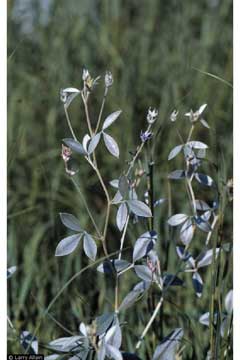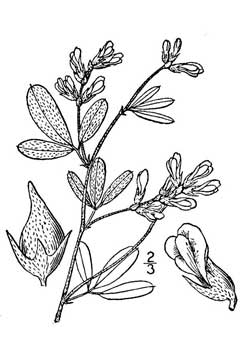 |
|
Larry Allain @ USDA-NRCS PLANTS Database |
 |
| USDA-NRCS PLANTS Database / Britton, N.L., and A. Brown. 1913. An illustrated flora of the northern United States, Canada and the British Possessions. 3 vols. Charles Scribner's Sons, New York. Vol. 2 |
Translate this page:
Summary
Silverleaf breadroot is one of several edible Pediomelum species with starchy, carbohydrate-rich roots. While not abundant enough to rely on heavily, the roots are of good quality when peeled and cooked, and they can be eaten fresh, dried, ground into flour, or even fried for a snack. A useful but scarce wild food. This name is a synonym of Pediomelum argophyllum. Pediomelum argophyllum is an erect, widely-branched, herbaceous perennial plant growing from a swollen rootstock; the stems are often zig-zag, and they can be 30 - 60cm tall[235
].
The plant is harvested from the wild for local use as food, medicine, and a source of materials. Within its native range, it can be used as a soil stabilizer.
Physical Characteristics

 Psoralea argophylla is a PERENNIAL growing to 0.6 m (2ft).
Psoralea argophylla is a PERENNIAL growing to 0.6 m (2ft).
See above for USDA hardiness. It is hardy to UK zone 5. The species is hermaphrodite (has both male and female organs) and is pollinated by Insects.
It can fix Nitrogen.
Suitable for: light (sandy), medium (loamy) and heavy (clay) soils and prefers well-drained soil. Suitable pH: mildly acid, neutral and basic (mildly alkaline) soils. It cannot grow in the shade. It prefers dry or moist soil.
UK Hardiness Map
US Hardiness Map
Synonyms
Pediomelum argophyllum. (Pursh.)J.Grimes.
Plant Habitats
Cultivated Beds;
Edible Uses
Edible Parts: Root
Edible Uses:
Root - raw or cooked[105, 161]. The root can also be dried and ground into a powder then used in soups or with cereals for making bread etc[161]. Edible Uses & Caution:
Only the roots of silverleaf breadroot and related species are edible. All other parts are inedible. Breadroots were historically important food plants, particularly Indian breadroot (P. esculentum) of the Great Plains, though that species is largely absent from the Southwest. Southwestern species, including silverleaf breadroot, were used less frequently due to their scarcity [2-3]. Food Potential: The roots of silverleaf breadroot are rich in carbohydrates and of good quality when found in sufficient size. They are typically off-white with brown skins, and most of the root is reasonably chewable except for the cores. The skins are bitter, so peeling is recommended. Boiling improves the flavor by drawing out bitterness and softening the texture, producing a pleasant, starchy taste. Roots can also be baked, added to soups, or dried and ground into flour. Dried shavings reconstitute well in water and can even be fried for a nutritious snack [2-3]. Quality and yield vary—some plants produce substantial roots worth the effort of harvesting, while others offer little. Vigorous plant growth is often a sign of more robust roots below ground [2-3].
References More on Edible Uses
Medicinal Uses
Plants For A Future can not take any responsibility for any adverse effects from the use of plants. Always seek advice from a professional before using a plant medicinally.
Febrifuge Laxative
A tea made from finely ground leaves and stems is used as a febrifuge[213 ]. A decoction of the plant can be used as a wash for wounds[257 ]. A root infusion is used to treat chronic constipation[257 ].
References More on Medicinal Uses
The Bookshop: Edible Plant Books
Our Latest books on Perennial Plants For Food Forests and Permaculture Gardens in paperback or digital formats.

Edible Tropical Plants
Food Forest Plants for Hotter Conditions: 250+ Plants For Tropical Food Forests & Permaculture Gardens.
More

Edible Temperate Plants
Plants for Your Food Forest: 500 Plants for Temperate Food Forests & Permaculture Gardens.
More

More Books
PFAF have eight books available in paperback and digital formats. Browse the shop for more information.
Shop Now
Other Uses
References More on Other Uses
Cultivation details
Pediomelum argophyllum is native to the central belt of N. America, from southern Canada to Texas, and, as such, will be subject to a continental climate in much of its range with very hot summers and very cold winters. Species in this genus generally require well-drained soil in a sunny position, succeeding in most soils[1 , 200 ]. Plants are very intolerant of root disturbance; they are best planted out into their permanent positions whilst still small[200 ]. This species has a symbiotic relationship with certain soil bacteria; these bacteria form nodules on the roots and fix atmospheric nitrogen. The growing plant utilizes some of this nitrogen, but some can also be used by other plants growing nearby[200 ]. Habitat & Range: Silverleaf breadroot occurs mainly on the Great Plains and extends into parts of the Southwest, though it is too uncommon to be considered a staple food. Plants grow in open, dry habitats, where their storage roots help them survive harsh conditions. USDA Hardiness Zone: 4–8.
Weed Potential: Low – silverleaf breadroot is native, non-invasive, and not considered a weedy threat.
References Carbon Farming Information and Carbon Sequestration Information
Temperature Converter
Type a value in the Celsius field to convert the value to Fahrenheit:
Fahrenheit:
The PFAF Bookshop
Plants For A Future have a number of books available in paperback and digital form. Book titles include Edible Plants, Edible Perennials, Edible Trees,Edible Shrubs, Woodland Gardening, and Temperate Food Forest Plants. Our new book is Food Forest Plants For Hotter Conditions (Tropical and Sub-Tropical).
Shop Now
Plant Propagation
Pre-soak the seed for 24 hours in warm water and then sow in early to mid spring in a greenhouse. Either sow the seed in individual pots or pot up the young seedlings as soon as possible in order to avoid root disturbance. Grow them on in the pots until planting out in their final positions. It is usually impossible to transplant this species without fatal damage to the root[200]. Division in spring. With great care since the plant resents root disturbance. It is virtually impossible to divide this species successfully[200].
Other Names
If available other names are mentioned here
Silverleaf Indian breadroot. Silverleaf Breadroot (Pediomelum argophyllum (Pursh) J. W. Grimes = Psoralea argophylla Pursh)
Native Range
NORTHERN AMERICA: Canada (Saskatchewan (south), Alberta (south), Manitoba (south)), United States (Iowa, Kansas, Minnesota, Missouri (west), Nebraska, North Dakota, Oklahoma (north), South Dakota, Wisconsin, Colorado (east), Montana (east), Wyoming (east), New Mexico (northeast))
Weed Potential
Right plant wrong place. We are currently updating this section.
Please note that a plant may be invasive in one area but may not in your area so it's worth checking.
Low – silverleaf breadroot is native, non-invasive, and not considered a weedy threat.
Conservation Status
IUCN Red List of Threatened Plants Status :

Growth: S = slow M = medium F = fast. Soil: L = light (sandy) M = medium H = heavy (clay). pH: A = acid N = neutral B = basic (alkaline). Shade: F = full shade S = semi-shade N = no shade. Moisture: D = dry M = Moist We = wet Wa = water.
Now available:
Food Forest Plants for Mediterranean Conditions
350+ Perennial Plants For Mediterranean and Drier Food Forests and Permaculture Gardens.
[Paperback and eBook]
This is the third in Plants For A Future's series of plant guides for food forests tailored to
specific climate zones. Following volumes on temperate and tropical ecosystems, this book focuses
on species suited to Mediterranean conditions—regions with hot, dry summers and cool, wet winters,
often facing the added challenge of climate change.
Read More
Expert comment
Author
Pursh.
Botanical References
43235
Links / References
For a list of references used on this page please go here
Readers comment
| Add a comment |
|
If you have important information about this plant that may help other users please add a comment or link below. Only comments or links that are felt to be directly relevant to a plant will be included. If you think a comment/link or information contained on this page is inaccurate or misleading we would welcome your feedback at [email protected]. If you have questions about a plant please use the Forum on this website as we do not have the resources to answer questions ourselves.
* Please note: the comments by website users are not necessarily those held by PFAF and may give misleading or inaccurate information.
To leave a comment please Register or login here All comments need to be approved so will not appear immediately.
|
Subject : Psoralea argophylla
|
|
|
|